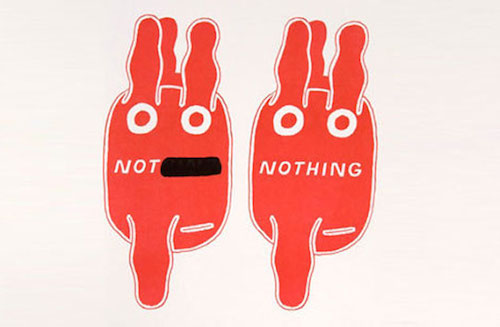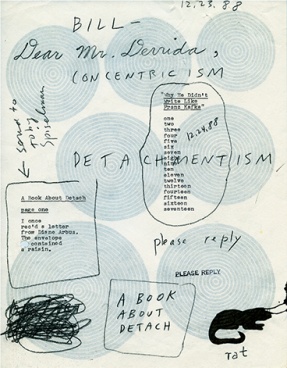Andrew Douglas Johnson: “Return Service Requested”
 Not Nothing: Selected Writings, 1954-1994
Not Nothing: Selected Writings, 1954-1994
Ray Johnson
Siglio Press, 2014
People don’t write letters anymore. People don’t even write emails. Ray Johnson wrote letters, an effusion of them, too many to collect. Siglio Press has made two Ray Johnson books. One is the art book and one is the words book and that distinction is hardly useful but Siglio has done its job well—the physical thing of book-making. The words one is called Not Nothing, edited by Elizabeth Zuba, and because of bad planning and itinerancy and profligacy, I own two copies of it. One copy is coffee stained all on one edge and coffee stained deep into the supple paperiness of the cover. The cover feels excellent and looks excellent: 4 stars. 8 stars because of the two copies. 7.5 stars if we take into account the coffee stains.
Not Nothing is an archive, but no one writes an archive. One writes a poem or a novelbook or a thingy. Ray Johnson mostly wrote thingies—epistolary poetry squawks or squawking poetic epistles—that he sent through the mail to witting and unwitting recipients. The pages of Not Nothing seem to want to pull away from one another or dissolve out of their proximity to one another. Not the actual pages, but the collected ephemera printed on each page.
Each letter in Not Nothing had a life of its own. It circulated. It had a sender, a recipient, a time in between—an uncertainty, a not-knowing. At least part of each poem (perhaps the largest part) was its fact as a letter. When you or I sit down to read this book we can’t read that poem. We can only read the trace. We can never read the body of Ray Johnson’s work because there was no body/is no body. Even the addressees or members of the New York Correspondance School [sic] (founded by RJ for mail-making purposes) could only see each poemletterdrawing as an event. The poem wasn’t just words, but words and a thing and time and distance.
 The book can’t capture all of this. It has to be a book. And it can be and is, even if Ray Johnson didn’t write it. Per se. Coherence is a sin Ray Johnson would not be accused of. The book includes a kind of interview between David Bourdon and Johnson. Bourdon: “Are you an ‘artist?’” Johnson: “I’m a listening, measuring, looking, killing, opening, giving, squooshing, eating flag-maker.” His life or his work was elision and slippage and any number of other deconstructionist hole words. The letters bound together are a deadening (a corpsification) which can’t necessarily be blamed on the book makers as they are not the ones responsible. Ray Johnson is dead, and has been, and that is a negation that makes Not Nothing necessary. There is no further circulation, only a collecting of remains. Zuba says in the introduction: “Illusion, the elusive, the ephemeral and the void are the essential form and content of Johnson’s writing and mail art.” In the same essay, she acknowledges the impossibility of this book. As an archive of a life hurled through the postal system, it is not everything. But it is not nothing.
The book can’t capture all of this. It has to be a book. And it can be and is, even if Ray Johnson didn’t write it. Per se. Coherence is a sin Ray Johnson would not be accused of. The book includes a kind of interview between David Bourdon and Johnson. Bourdon: “Are you an ‘artist?’” Johnson: “I’m a listening, measuring, looking, killing, opening, giving, squooshing, eating flag-maker.” His life or his work was elision and slippage and any number of other deconstructionist hole words. The letters bound together are a deadening (a corpsification) which can’t necessarily be blamed on the book makers as they are not the ones responsible. Ray Johnson is dead, and has been, and that is a negation that makes Not Nothing necessary. There is no further circulation, only a collecting of remains. Zuba says in the introduction: “Illusion, the elusive, the ephemeral and the void are the essential form and content of Johnson’s writing and mail art.” In the same essay, she acknowledges the impossibility of this book. As an archive of a life hurled through the postal system, it is not everything. But it is not nothing.
In an archive, patterns emerge. In an archive of letters, names turn one after another. They build a collective, networked heft. The names in Not Nothing make for a way to imagine a letter or a way to imagine the closeness that happens when a letter is written or sent or read. Consider Frank O’Hara and his satellites: the way New York School cameos trip the feeling of recognition across time. The feeling of seeing a face from a former life in some unexpected place today, a utilitarian bar or fast casual dining establishment. The dear and the sincerely and the motel stationery in this book of Johnson, the tossed-off quotidian detail, give the same shot of where-I’m-calling-from closeness. A December 16, 1967 letter addressed to William T. Wiley starts: “Have had the shakes and chills and fever and bundled up/ in blankets the best one being the one I stole from the Pull-/man train./ Was very touched by your beautiful sad drawings received today after a nightmare my hands were all cramped the phone rang I could hardly touch.”
What happens in Not Nothing is that the closeness is withdrawn or recast as the impossibility of closeness. The form and ritual of correspondence give cover for this breakdown. The letter to Wiley goes on, “Have been doing things to my face like the Duchamp american/ flag I have turkey neck skin and do I need help. I wroyet/ to Ara Armenian big nose to say you’d like to see the/ Armenian-Turkish atrocity photos on his screen like real/ big. I assume you’d like this wouldn’t you?” Substance crafted out of negation remains in an unsteady state, like the self or “I” does. The something of Not Nothing is speculative and imaginary, like books are. Above the dateline in the Wiley letter: “May I send you my complete life?”
—
Andrew Douglas Johnson writes and translates and makes art. He was born in Denver and lives elsewhere. He holds a master’s in Comparative Literature from Dartmouth College, and studies Latin America at the University of Michigan. His nails are brilliantly manicured.
